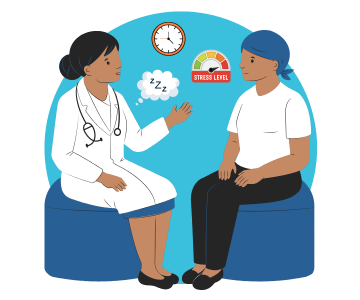How to Talk About Nutrition with People With Diabetes
A resource for healthcare heroes
Living with diabetes can transform a person’s relationship with food and nutrition. Whether someone is interested in using nutrition to help manage their weight, eating their favorite foods with the right insulin dose, or understanding how foods impact glucose levels, each individual will have unique priorities when it comes to nutrition guidance.

Discussions about food choices and nutrition can often be judgmental, complicated, and even harmful to a person’s relationship with food. This guide is designed to help you navigate these conversations in a more respectful and individualized way for people living with diabetes.
General language guidance
People with diabetes, their families, and people at risk of diabetes deserve communications that are clear and accurate, respectful, inclusive, and free from judgment and bias.
No matter what the topic, there are some basic guidelines that everyone can implement. Choose to use language that:
- Is neutral, nonjudgmental, and based on facts, actions, or physiology/biology.1,2
- Is strengths-based, respectful, inclusive, and imparts hope.1,2
- Is person-centered.1,2
- Fosters collaboration between people with diabetes and healthcare teams.1,2
When a conversation with a person living with diabetes centers around nutrition, keep these important general guidelines in mind:
- Nutrition choices should be based on each individual’s unique needs and life circumstances instead of a one-size-fits-all approach. It should be your goal as a healthcare provider to empower each person with the tools they need to make informed choices that suit their changing needs and help them achieve their management goals.
- As you work towards facilitating person-centered and collaborative relationships with the people with diabetes in your care, it’s important that you make sure they feel heard if asking questions or expressing hesitation or challenges with their nutrition plan. Ask questions that allow each person to have a say in the decision-making process for their care.
For more information about general language guidance that can help reduce diabetes stigma, including specific words and phrases to use (or avoid), visit the dStigmatize Language Guide.
Having a stigma-free conversation about nutrition
1. Emphasize strengths-based and informed decision-making, specific and evidence-based recommendations, and individual choice. Avoid black-and-white thinking and moral classifications.

All foods can have a place in a balanced eating pattern because there are no universally good or bad foods for people living with diabetes.3 Work alongside people to identify and address their concerns and barriers, foster collaborative decision-making, and focus on evidence-based guidance that supports short- and long-term physical and emotional well-being.
Make room for circumstances to change over time or even from moment to moment by providing recommendations that allow choices to be tailored to each individual, such as learning how to incorporate favorite or culturally relevant foods. Insulin on board, stress, hunger, social circumstances, access to food options, preferences, time, and other health factors are just some of the many factors that can impact needs and decisions.
Help reduce stress and stigma by emphasizing that nutrition choices are never a sign that someone has “failed” or is a “bad diabetic.” Praise informed decision-making, effort, and accomplishments.
2. Be mindful of past experiences, approach conversations with compassion and curiosity, and be an active listener.
Any time you have a conversation about diet and nutrition, it’s important to meet people where they are. This means taking into account a person’s previous experiences and relationship with nutrition, their knowledge about nutrition and meal preparation, their day-to-day lives, their personal health goals, and your own biases about nutrition and dietary patterns.
Approaches like motivational interviewing have been shown to be effective in supporting nutritional and behavioral changes for people living with diabetes.4,5 These skills may also be helpful for navigating difficult conversations when other challenges are present, such as experiences with disordered eating or weight management. More than half of people with diabetes report having experience with weight stigma, and another 10% or more with disordered eating.6,7 Rather than avoiding difficult topics, seek permission to approach sensitive topics and let the person in your care lead the conversation.
Ask questions that can help guide the conversation and provide evidence-based recommendations and resources. Aim to support the people with diabetes in your care in setting goals and making their own personalized decisions.
3. Use technology to foster greater autonomy and confidence.
Food decisions can be taxing and challenging, but diabetes technology like continuous glucose monitors (CGMs) can lift some of the mental burden of weighing choices and tracking outcomes.8 Even conventional blood glucose monitors can be used strategically to gauge the impact of specific food choices on glucose levels.

CGMs can provide invaluable, real-time data and evidence about the impact of specific food choices on blood glucose levels to inform management decisions. Access to these tools can give people the confidence to enjoy more foods while improving time in range, especially when CGMs are paired with insulin pumps for automated insulin delivery.
Explore the Time in Range Coalition’s resources to learn more about how these metrics can support diabetes management and confidence.
4. Seek referrals and additional support resources when necessary.
Discussing nutrition for people living with diabetes can be complicated, especially when additional factors such as comorbid health conditions, affordability, access, cultural considerations, pregnancy, and more are involved.
Do not be afraid to seek additional support or refer out to a provider who specializes in a facet of nutrition that aligns with the unique needs of each person with diabetes in your care. Other providers outside of nutrition may also be valuable members of the care team, such as mental healthcare professionals. Find a great provider directory here.
Choose the right words and phrases
Example 1
Instead of “adhere” or “comply”
adherence / compliance; e.g. adhere, (non-) adherent, comply, (non-) compliant
Choose
words that describe collaboration or specific behaviors, e.g. eating fiber-rich foods, monitoring blood glucose
Use
- “Ruth has a personalized nutrition plan that she enjoys.”
- “It seems like your time in range is not quite at your goal. I know you’ve started on insulin since your last visit and made a plan to change some food choices. How has that been going; are you having any challenges?”
Rather than
- “Ruth is compliant and adheres to a strict diabetic diet.”
- “Your time in range is poor because you are nonadherent with your diet and insulin regimen.”
Rationale
Using terms that emphasize collaboration can be empowering and highlights that people with diabetes are not passive in the management of their condition, but should be a part of decision-making. Words like ‘adherence’ and ‘compliance’ suggest that healthcare professionals are always correct and that people with diabetes are disobeying them if they are not able to follow orders exactly. In reality, diabetes management is more complicated than simply ‘following orders,’ and terms like ‘adherent’ and ‘compliant’ ignore the many challenges people with diabetes face every day.
It is accurate, descriptive, and neutral to describe the actual choices or behaviors of a person with diabetes and the effects it has on health outcomes like diabetes-related complications.
Example 2
Instead of “control”
control (referring to diabetes, HbA1c or glucose levels);
e.g poor control, good control, normal control, well controlled, poorly controlled, uncontrolled, glycemic control
Choose
manage glucose levels, within/outside target range, high/low glucose levels, target glucose levels, [“ …experienced ____ and the result was ____”]
Use
- “Lyle manages his diabetes with a personalized Mediterranean-style eating pattern.”
- “Are you open to discussing how nutrition can help you achieve your glycemic targets and reduce your risk of diabetes-related complications? I know food can be difficult to discuss, and I want you to know this is a judgment-free zone and there is no one “right” way to eat. What questions do you have for me?”
Rather than
- “Lyle controls his diabetes with diet.”
- “Because you have such poorly controlled diabetes, we are going to have to put you on a strict diet before you end up on insulin.”
Rationale
A person’s diabetes is influenced by many factors outside of their ‘control’ including socioeconomic factors, genetic risk factors, hormones, access to food, medications and technology, their environment, stress, etc.2
‘Manages’ is preferred over ‘controls’ because it acknowledges the effort people put in to maintain their health and it acknowledges the improvements people can make over time. The term ‘control’ can lead to feelings of guilt, shame, and frustration and incorrectly implies that if people try hard enough they can ‘control’ their diabetes or ‘prevent’ complications.2’
Example 3
Instead of “good” vs. “bad” foods
good or bad [food/choice], right or wrong [food/choice], healthy or unhealthy [food/choice], better or worse [foods/choices]
Choose
describe or name specific foods/choices/eating patterns/nutrition facts; balanced or informed choices, food
Use
- “Franny lowered her risk of developing certain complications related to diabetes and hypertension by choosing foods that are low in sodium.”
- “That birthday cake sounds like it was delicious. How did it impact your blood glucose levels? Is there anything you would adjust for next time?”
Rather than
- “Franny eliminated her risk of diabetic heart disease by changing her diet to good foods.”
- “You shouldn’t be eating unhealthy foods like birthday cake, that was the wrong choice.”
Rationale
Labels such as “good” and “bad” ascribe moral judgment to foods and food choices while implying a personal failure associated with making the wrong choices.1 This places a person with diabetes in a position of following inflexible rules that may not apply to all situations. Each food decision is highly context-specific. A “good” food in one situation may be a “bad” food under different circumstances, and assessing those changing contexts to take informed action supports diabetes management. Describing specific foods or choices and their potential impacts on physical and emotional well-being within the context of that specific scenario is more neutral, fact-based, and appropriate for supporting people with diabetes.1
Example 4
Instead of “eliminate”
eliminate or avoid [foods], restrict, cut out, off-limits
Choose
enjoy, increase, add, reduce, lower, lessen, adjust, tweak
Use
- “Enjoying sugar in moderation while adding more fiber, protein, and fat to meals can have positive impacts on blood glucose management.”
- “Kwame was able to adjust his favorite family recipe to enjoy it for the holidays.”
Rather than
- “Eliminate added sugar in the diet to control blood glucose levels.”
- “Kwame needs to avoid his mother’s cooking because their cultural cuisine is unhealthy.”
Rationale
Approach nutrition from a strengths-based angle and focus on foods to add and enjoy, rather than basing a meal plan on foods to restrict and avoid. A motivational interviewing approach can be helpful and has been shown to support the adoption of a variety of eating patterns and promote better health outcomes.4,5 There is also no evidence that suggests eliminating or avoiding specific foods altogether is necessary for diabetes management; nutrition choices should instead be individualized for each situation and context.3
Example 5
Instead of “diet”
diet, diabetes diet, diabetic diet
Choose
food choices or decisions, eating pattern
Use
- “Paulo is working on finding an eating pattern he enjoys that supports his diabetes management.”
- “Tell me about some recent food choices you’ve made. Are there any examples you’d like to walk through to help you feel even more confident with your decisions next time?”
Rather than
- “Paulo failed to control his diabetes through dieting.”
- “My patient has been prescribed a diabetic diet.”
Rationale
“Diets” are inherently temporary or refer to medically prescribed eating plans to treat specific health conditions. Such terminology can bring up negative feelings about potentially restrictive and controlling rules or limitations that are not necessary for people with diabetes. While there may be certain well-known eating patterns that provide a strong foundation for individualized nutrition plans, there is no single diet that can “cure” diabetes or “control” blood glucose levels. Making space for all foods and flexible food choices that suit each person’s own preferences, beliefs, and situation can empower autonomy, informed decision-making, and sustainable change, ultimately leading to improved nutrition- and diabetes-related outcomes.
This resource was created for dStigmatize, a diaTribe Foundation program, with support from Lilly Diabetes, AstraZeneca, and the Boehringer Ingelheim-Lilly Alliance.



Citations
- Dickinson, J. K., Guzman, S. J., Maryniuk, M. D., O’Brian, C. A., Kadohiro, J. K., Jackson, R. A., D’Hondt, N., Montgomery, B., Close, K. L., & Funnell, M. M. (2017). The Use of Language in Diabetes Care and Education. Diabetes care, 40(12), 1790–1799.
- Speight, J., Skinner, T. C., Dunning, T., Black, T., Kilov, G., Lee, C., Scibilia, R., & Johnson, G. (2021). Our language matters: Improving communication with and about people with diabetes. A position statement by Diabetes Australia. Diabetes research and clinical practice, 173, 108655.
- Evert, A. B., Dennison, M., Gardner, C. D., Garvey, W. T., Lau, K. H. K., MacLeod, J., Mitri, J., Pereira, R. F., Rawlings, K., Robinson, S., Saslow, L., Uelmen, S., Urbanski, P. B., & Yancy, W. S., Jr (2019). Nutrition Therapy for Adults With Diabetes or Prediabetes: A Consensus Report. Diabetes care, 42(5), 731–754.
- Salvia, M. G. & Quatromoni, P. A. (2023). Behavioral approaches to nutrition and eating patterns for managing type 2 diabetes: A review. American journal of medicine open, 9, 100034.
- Martins, R. K., & McNeil, D. W. (2009). Review of Motivational Interviewing in promoting health behaviors. Clinical psychology review, 29(4), 283–293.
- Himmelstein, M. S., & Puhl, R. M. (2021). At multiple fronts: Diabetes stigma and weight stigma in adults with type 2 diabetes. Diabetic medicine : a journal of the British Diabetic Association, 38(1), e14387.
- Dziewa, M., Bańka, B., Herbet, M., & Piątkowska-Chmiel, I. (2023). Eating Disorders and Diabetes: Facing the Dual Challenge. Nutrients, 15(18), 3955.
- Lawton, J., Blackburn, M., Allen, J., Campbell, F., Elleri, D., Leelarathna, L., Rankin, D., Tauschmann, M., Thabit, H., & Hovorka, R. (2018). Patients’ and caregivers’ experiences of using continuous glucose monitoring to support diabetes self-management: qualitative study. BMC endocrine disorders, 18(1), 12.